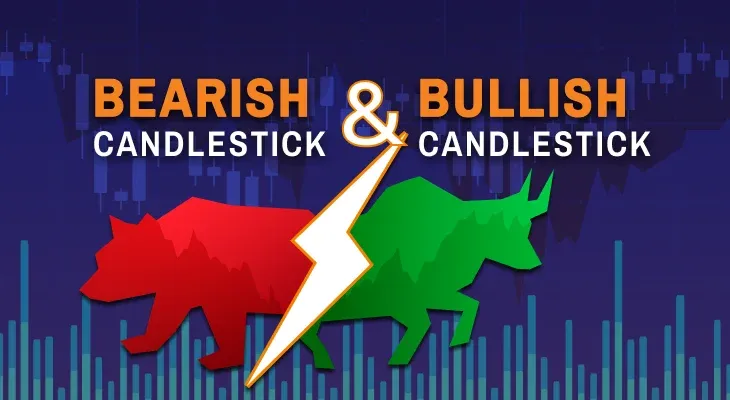
How to Read Breakaway Bullish and Bearish Candlestick Chart Patterns?
The history of candlesticks dates back to the 17th century when a Japanese rice trader, Homma Munehisa, invented them. The rest of the world could only learn about it when Steve Nison wrote his book ‘Japanese Candlestick Charting Techniques’ in 1991.
As per the concept, four components are put together to make a single candlestick. They are open, high, low, and closing prices. The open and closing prices make the candle body whereas the high and low prices form upper and lower shadows respectively.
If the open price is lower than the closing price, it indicates bullishness and is represented in green colour. And on the contrary, if the open price is higher than the closing price, it indicates bearishness and is represented by red colour.
Each candle indicates a summary of price movement that undertook within a given timeframe. For instance, a one-day candle represents one trading session. And consequently, the open, high, low, and closing prices of that candlestick indicate the price movement for that particular day. So, in one week, there will be 5 candlesticks as there are 5 trading sessions from Monday to Friday.
Such multiple candlesticks are put together to form a candlestick chart. And such a chart forms various patterns. These bullish/bearish candlestick patterns are interpreted as logical premises for trading. One such pattern is – the breakaway pattern. And in this article, we will learn about it in detail.
Understanding Bullish Breakaway Pattern
The bullish breakaway pattern has five candlesticks and as the name suggests, it indicates bullishness. It usually forms in a downtrend. Here’s how you can recognise this pattern:
The first candlestick is a big red bearish candle.
The second candlestick is another red bearish candle, but smaller than the first one.
The third candlestick is a Doji with a small body and long shadows. This candle could be green or red.
The fourth candlestick is slightly higher than the third candle. Again, it could be either green or red.
The fifth candlestick, the final one, is a big green bar creating a bullish engulfing pattern.
This pattern indicates that the bears have lost the battle and bulls have taken control of prices. However, you must wait for the confirmation candlestick to form in the direction of bullish reversal before initiating a long trade.
Understanding Bearish Breakaway Pattern
The opposite of the bullish breakaway pattern is the bearish breakaway pattern, indicating bearishness. It typically forms in an uptrend. Look for the following attributes to recognise a bearish breakaway pattern:
The first candlestick is a big green bullish candle.
The second one is another green bullish candle, slightly smaller than the first one.
The third candlestick is the indecisive Doji candle with an inexistent body and long shadows. This candle could be green or red.
The fourth candlestick is slightly lower than the third one. It could be either a green or a red candle.
The final fifth candlestick is a big red one creating a bearish engulfing pattern.
The bearish breakaway pattern indicates that the uptrend could halt and a probable reversal could be on the cards. But before initiating a short trade, you must always wait for the confirmation candle to form in the direction of bearish reversal.
Key Considerations in Trading Breakaway Patterns
Trading the reversal bullish engulfing pattern and bearish engulfing pattern could get tricky. Thus, you must take note of the following considerations before initiating a trade.
Most bullish reversal patterns fail in a strong downtrend and most bearish reversal patterns fail in a strong uptrend. Therefore, you must trade them very cautiously.
Usually, at the top of an uptrend or the bottom of a downtrend, markets tend to become very volatile. Trading in such a market could be difficult as there is an increased possibility of breakout failure.
Breakaway patterns are five candlestick patterns. Including the confirmation candle, it takes the formation of 6 candles for a tradeable setup to build. Thus, it demands a high level of patience. Moreover, since the length of the candlestick is big, the stop loss is higher in such trades.
In a Nutshell
The breakaway bullish engulfing pattern and bearish engulfing pattern are widely used by traders in the stock market. While the success ratio of these patterns depends on the follow-up candles, you must not impulsively trade on any of these setups. Always conduct due diligence and predefine the risk as per your appetite before entering into a trade.

